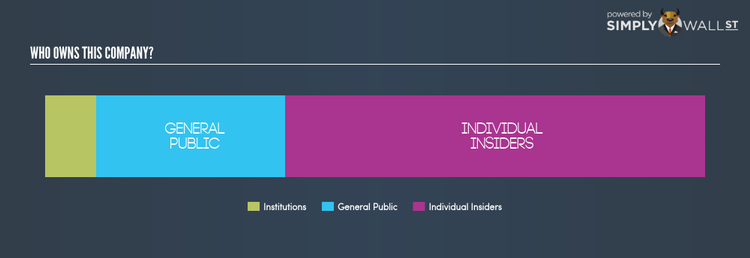Why The InterGroup Corporation’s (NASDAQ:INTG) Investor Composition Impacts Your Returns

In this article, I will take a quick look at The InterGroup Corporation’s (NASDAQ:INTG) recent ownership structure – an unconventional investing subject, but an important one. A company’s ownership structure is often linked to its share performance in both the long- and short-term. Differences in ownership structure of companies can have a profound effect on how management’s incentives are aligned with shareholder returns, which is why we’ll take a moment to analyse INTG’s shareholder registry. All data provided is as of the most recent financial year end.
See our latest analysis for InterGroup
Institutional Ownership
Institutional investors are one of the largest group of market participants and their buy-sell decisions on a company’s stock can significantly impact prices, more so, when there are relatively small amounts of shares available on the market to trade. A low institutional ownership of 7.84% puts INTG on a list of companies that are not likely exposed to spikes in volatility resulting from institutional trading. Stocks with low coverage such as INTG, attracts renowned investor Peter Lynch, who has benefited from the momentum of institutions buying into a stock as it gained popularity.
Insider Ownership
Another important group of shareholders are company insiders. Insider ownership has to do more with how the company is managed and less to do with the direct impact of the magnitude of shares trading on the market. A major group of owners of INTG is individual insiders, sitting with a hefty 63.49% stake in the company. Broadly, insider ownership of this level has been found to negatively affect companies with consistently low PE ratio (underperforming). And a positive impact has been seen on companies with a high PE ratio (outperforming). It’s also interesting to learn what INTG insiders have been doing with their shareholdings lately. Insider buying may be a sign of upbeat future expectations, however, selling doesn’t necessarily mean the opposite as insiders may be motivated by their personal financial needs.
General Public Ownership
A substantial ownership of 28.66% in INTG is held by the general public. This size of ownership gives retail investors collective power in deciding on major policy decisions such as executive compensation, appointment of directors and acquisitions of businesses. This level of ownership gives retail investors the power to sway key policy decisions such as board composition, executive compensation, and potential acquisitions. This is a positive sign for an investor who wants to be involved in key decision-making of the company.
What this means for you:
Institutional ownership in INTG is not at a level that would concern investors. We are less likely to see sustained downtrends or significant volatility resulting from large institutional trading. However, if you are building an investment case for INTG, ownership structure alone should not dictate your decision to buy or sell the stock. Rather, you should be examining fundamental factors such as the intrinsic valuation, which is a key driver of InterGroup’s share price. I urge you to complete your research by taking a look at the following:
NB: Figures in this article are calculated using data from the last twelve months, which refer to the 12-month period ending on the last date of the month the financial statement is dated. This may not be consistent with full year annual report figures.
To help readers see pass the short term volatility of the financial market, we aim to bring you a long-term focused research analysis purely driven by fundamental data. Note that our analysis does not factor in the latest price sensitive company announcements.
The author is an independent contributor and at the time of publication had no position in the stocks mentioned.

